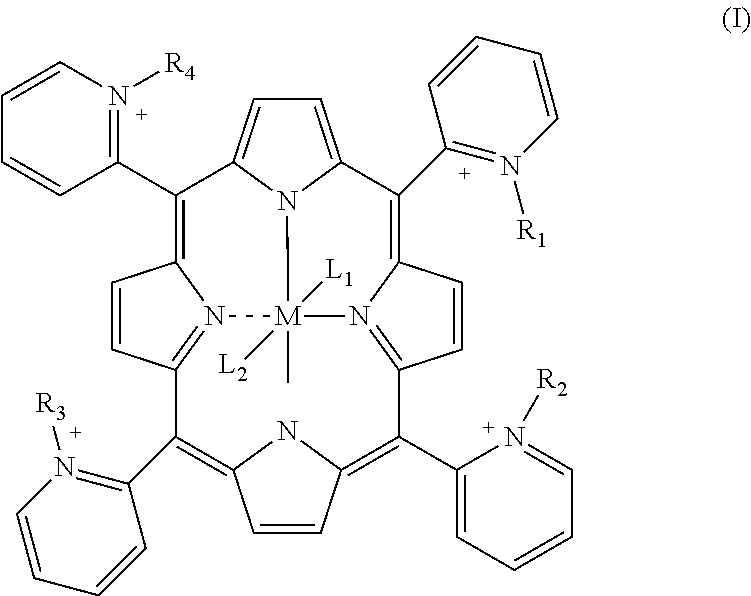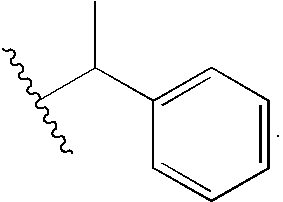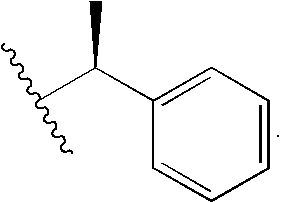Porphyrin catalysts and methods of use thereof
a technology of porphyrin and catalyst, which is applied in the field of substituted porphyrin compounds, can solve problems such as damage to biological targets, and achieve the effects of high catalytic activity, enhanced lifetime in the blood pool, and high stability
- Summary
- Abstract
- Description
- Claims
- Application Information
AI Technical Summary
Benefits of technology
Problems solved by technology
Method used
Image
Examples
example 1
Synthesis of zinc(II)-2-TRMBzPvP
Synthesis of R-(+)-methylbenzybromoacetamide
Liu, S.; Pietryka, J.; Ellars, C. E.; Edwards, D. S. Bioconjugate Chem. 2002, 13, 902-913
[0157]To 20 mL of dry dioxane was added 0.48 g (3.47 mmol) bromoacetic acid and 0.39 g (3.47 mmol) N-hydroxysuccinimide. DCC, 0.79 g (3.82 mmol) was dissolved in 10 mL dioxane and added via pipette to the stirred solution. Dicyclohexylurea precipitated as a milky solid and was filtered off after 2 hr. (R)-(+)-methylbenzylamine, 0.37 g (3.13 mmol) was added to the filtrate and the mixture was stirred for 5 hr, until the reaction was complete by tlc. The dioxane was removed and the residue was taken up in EtOAc, and the organic layer was washed with 40 mL 10% citric acid, 40 mL NaCO3, and brine. The organic layer was dried over Na2 SO4 and the solvent was removed to leave (R)-(+)-methylbenzylbromoacetamide (5) as a white solid. Purification by column chromatography (2:8 EtOAc:CH2Cl2) left the bromoacetamide in 80% yield as...
example 2
Synthesis of zinc(II)-2-TRBor PyP
Synthesis of R-(+)-bornylbromoacetamide
[0161]Bromoacetic acid, 503 mg (3.62 mmol), N-hydroxysuccinimide, 417 mg (3.62 mmol) and DCC, 823 mg (3.98 mmol) were dissolved in 50 mL dioxane in an oven dried flask and stirred for an hr. After an hr the reaction mixture was filtered and 500 mg (3.26 mmol) R-(+)-bornylamine was added to it. The reaction mixture was stirred overnight and the reaction was stopped when there was no unreacted starting material as checked by TLC. The solvent was evaporated and the residue was redissolved in ethyl acetate and washed with 10% citric acid, 5% sodium carbonate and saturated NaCl solutions. The organic layer was dried over sodium sulfate and evaporated to give the crude product which was purified by silica gel column chromatography (1:9 EtOAc:CH2C2) to yield 847 mg (94%) R-(+)-bornylbrornoacetamide.
Synthesis of 2-tetrakis-(N—R-(+)-bornylacetamido)-pyridyl porphyrin
[0162]2-PyP, 25 mg (0.04 mmol) and R-(+)-bornylbromoace...
example 3
Synthesis of Iron(III) chloride meso-tetrakis-2-(N-(2-methoxy)ethyl)pyridyl porphyrin
Synthesis of 2-methoxyethyl tosylate
[0164]2-methoxyethanol (0.989 g, 13 mmol) was dissolved in 30 ml dichloromethane, and triethylamine (2.53 g, 25 mmol) was added to the solution. The reaction mixture was set to stir in an ice-water bath, and p-toluenesulfonyl chloride (3.22 g, 17 mmol) was added all at once. The ice was allowed to melt, and the reaction was continued overnight. The reaction mixture was then filtered, to remove all of the triethylamine hydrochloride, and the filtrate was washed with ml saturated NaHCO3(aq), then 30 ml 1N KHSO4(aq), then 30 ml saturated NaHCO3(aq). The organic layer was dried over anhydrous magnesium sulfate, and the solvent was removed by distillation. The colorless oily residue was chromatographed on silica gel in 1:5 ethyl acetate:chloroform, to yield 2.77 g (92% yield) of 2-methoxyethyl tosylate as a viscous liquid.
[0165]1H NMR (300 MHz, CDCl3): δ2.4 (s, 3H, ArC...
PUM
 Login to View More
Login to View More Abstract
Description
Claims
Application Information
 Login to View More
Login to View More - R&D
- Intellectual Property
- Life Sciences
- Materials
- Tech Scout
- Unparalleled Data Quality
- Higher Quality Content
- 60% Fewer Hallucinations
Browse by: Latest US Patents, China's latest patents, Technical Efficacy Thesaurus, Application Domain, Technology Topic, Popular Technical Reports.
© 2025 PatSnap. All rights reserved.Legal|Privacy policy|Modern Slavery Act Transparency Statement|Sitemap|About US| Contact US: help@patsnap.com



